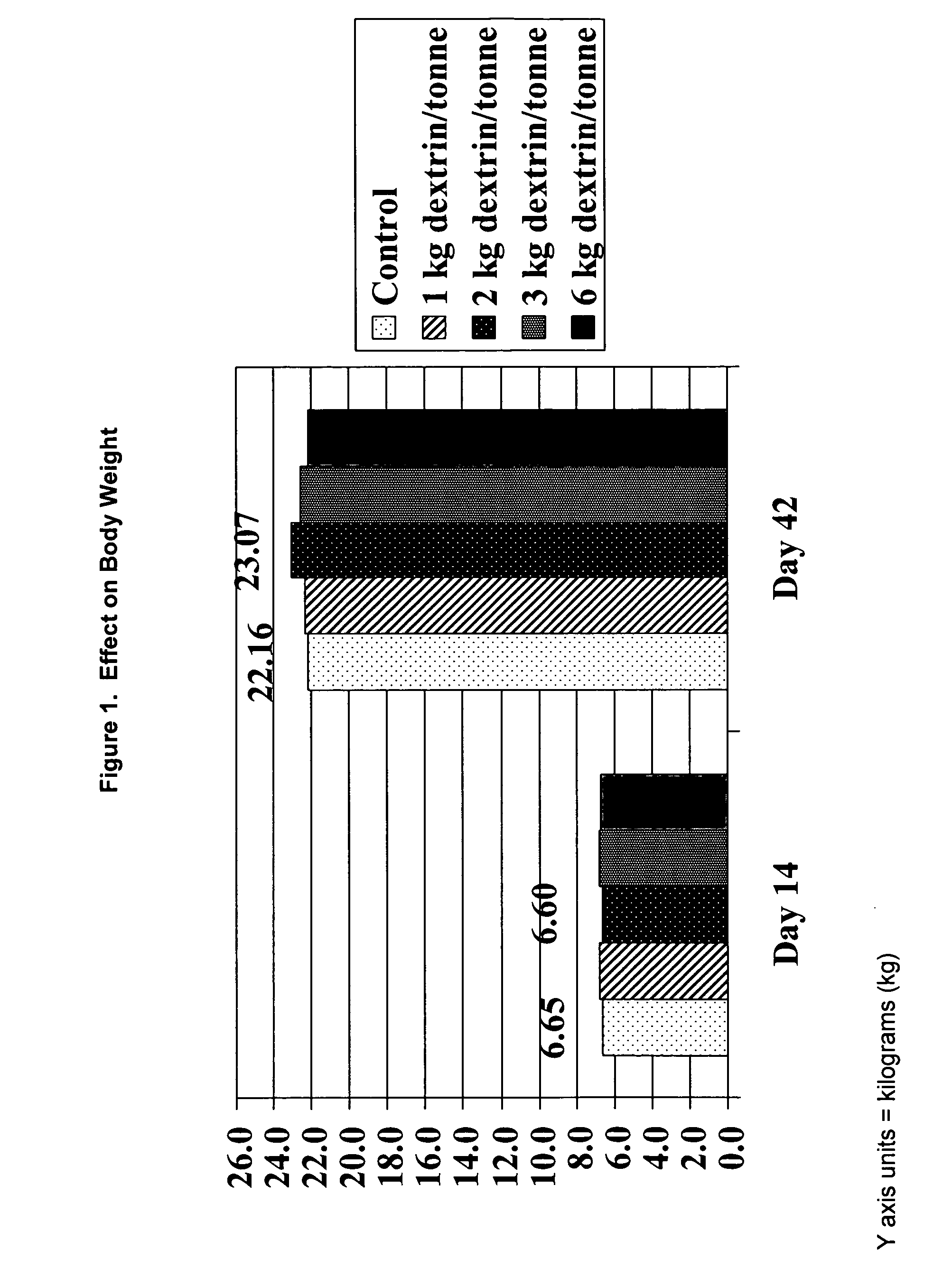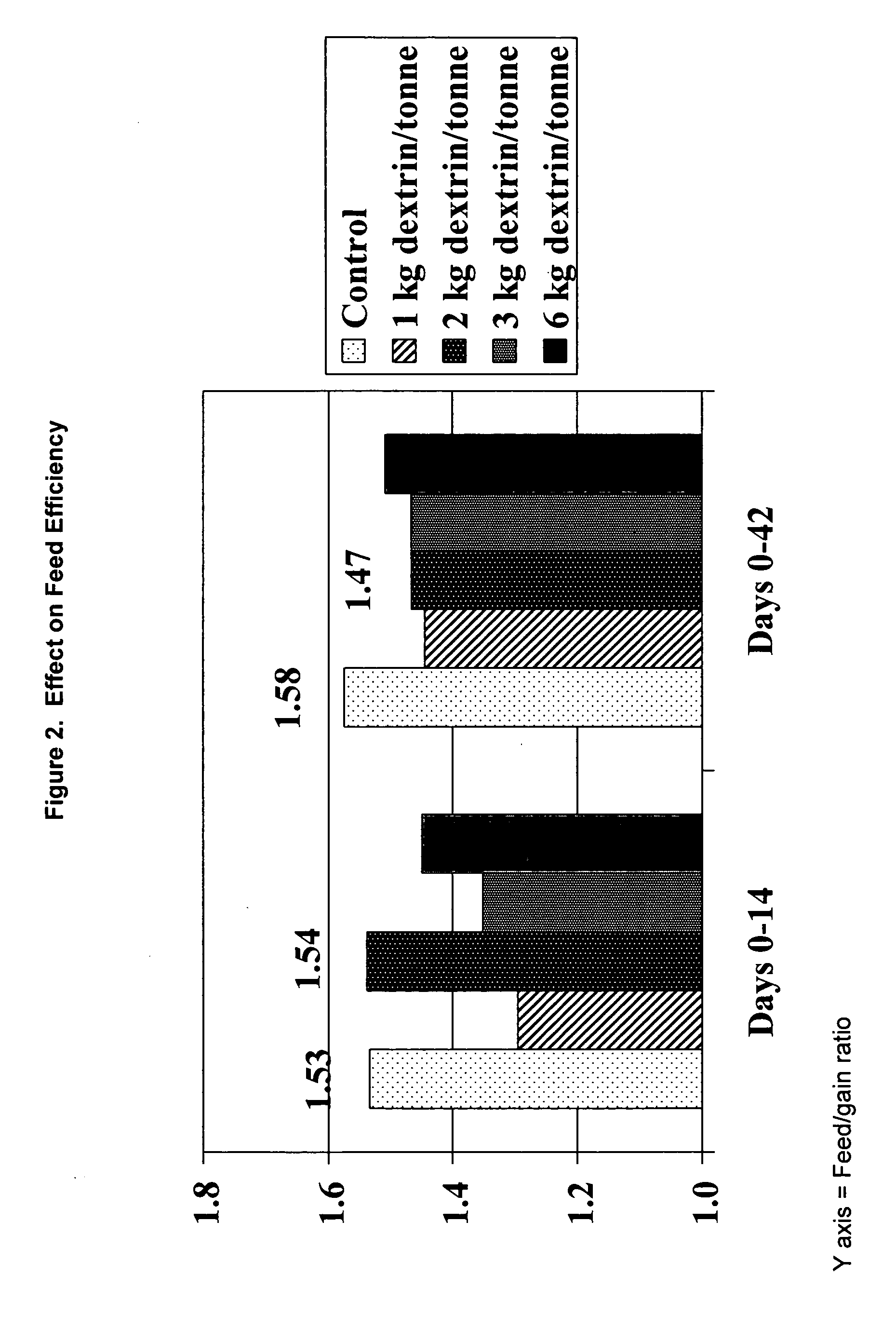Use of dextrin in animal feeds
- Summary
- Abstract
- Description
- Claims
- Application Information
AI Technical Summary
Benefits of technology
Problems solved by technology
Method used
Image
Examples
example 1
Complete Feeds
[0060] In this Example, four samples of complete feed compositions comprising a wheat dextrin product according to the present disclosure are described. The four complete feed compositions are suitable for use as a nursery feed composition for nursery swine. The complete feed compositions were made by a conventional manufacturing process that is typically used in the feed industry to produce pellet or meal complete feeds. The compositions of the four complete feeds are listed in Table 1. All ingredient amounts were measured in weight percent of total feed composition.
TABLE 1Complete Feed Compositions for Nursery SwineIngredients (weight %)Feed IFeed IIFeed IIIFeed IVGrain Products25.3632.9348.4654.66Plant Protein20.3025.0029.7231.17Animal Protein24.3111.124.68Grain By-Products5.0010.002.002.00Fat2.603.382.613.79Others7.464.085.793.39Wheat Dextrin0.300.300.300.30Total100.00100.00100.00100.00Protein, %24.7623.5821.9820.97Fat; Crude, %5.616.745.246.24Dry Matter, %90.74...
example 2
Concentrates
[0061] In this Example, four animal feed concentrates comprising a soluble dextrin product of the present disclosure are presented. The concentrates may be added to a feed product to produce a final feed formulation. The four concentrates are configured for use in swine feed compositions. The concentrates were made by using a conventional manufacturing process that is typically used in the feed industry to produce concentrates. The compositions of the four concentrates are listed in Table 2. All ingredient amounts were measured in weight percent of total concentrate composition.
[0062] The concentrates were mixed with other feed ingredients, such as, for example, corn, to make a complete feed composition using a conventional manufacturing process that is typically used in the feed industry to produce pellet or meal feed mixed with a concentrate.
TABLE 2Compositions for Swine ConcentratesIngredients (weight %)Conc. IConc. IIConc. IIIConc. IVPlant Protein72.1121.9075.826...
example 3
Pre-mixes
[0065] In this Example, four pre-mix compositions comprising a wheat dextrin product according to the present disclosure are described. The pre-mix compositions may be added to a feed product, such as, for example, by mixing into the feed product prior to feeding. The four pre-mix compositions are configured for mixing with swine feed products. The pre-mix compositions were made using a conventional manufacturing process that is typically used in the feed industry to produce pre-mixes. The compositions of the four pre-mix compositions are listed in Table 3. All ingredient amounts were measured in weight percent of total pre-mix.
TABLE 3Compositions for Swine Pre-mixesIngredients(weight %)Pre-mix IPre-mix IIPre-mix IIIPre-mix IVGrain By-Products——15.009.65Animal Protein——4.0018.55Plant Protein——3.559.20Minerals87.2882.9258.9352.60Vitamins1.101.670.991.68Trace Minerals2.622.635.432.75Fat1.001.001.30—Others—5.086.800.27Wheat Dextrin8.006.704.005.30Total100.00100.00100.00100....
PUM
 Login to View More
Login to View More Abstract
Description
Claims
Application Information
 Login to View More
Login to View More - Generate Ideas
- Intellectual Property
- Life Sciences
- Materials
- Tech Scout
- Unparalleled Data Quality
- Higher Quality Content
- 60% Fewer Hallucinations
Browse by: Latest US Patents, China's latest patents, Technical Efficacy Thesaurus, Application Domain, Technology Topic, Popular Technical Reports.
© 2025 PatSnap. All rights reserved.Legal|Privacy policy|Modern Slavery Act Transparency Statement|Sitemap|About US| Contact US: help@patsnap.com



